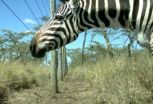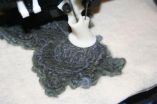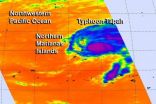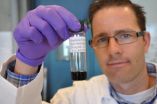(Press-News.org) Washington, DC—The World Health Organization's tool for assessing bone fracture risk underestimates the true dangers for people who are younger than 65 or have been treated for a single broken bone, according to a new study published in the Endocrine Society's Journal of Clinical Endocrinology & Metabolism (JCEM).
A WHO task force developed the Fracture Risk Assessment Tool (FRAX) to help predict the likelihood of adults between the ages of 40 and 90 breaking a bone. FRAX is designed to evaluate the chances that a person will break a bone in a minor fall, which is called a fragility fracture. Such fractures can reduce mobility and even increase the risk of death.
The FRAX tool is designed to help physicians identify osteoporosis cases that cannot be readily diagnosed through bone mineral density testing. More than half of fragility fractures occur in people who do not meet the bone mineral density standards to be diagnosed with osteoporosis.
"Although FRAX is a helpful tool and provides important information, it should not be used as the unique and definitive gold standard for determining whether or not to treat a patient for osteoporosis or weakening bones," said one of the study's authors, Gilles Boire, MD, MSc, of the University of Sherbrooke in Quebec, Canada. "The test fails to identify some patients who would benefit from treatment to prevent future fractures."
The prospective cohort study used the Canadian BMI-FRAX form of the tool to gauge fracture risk among 1,399 patients who were identified with a fragility fracture between June 2007 and May 2012. The Canadian version of the tool incorporates national data on fracture rates.
Prior to sustaining the fragility fracture, only 42.7 percent of these patients were considered high risk, according to the Canadian BMI-FRAX tool. Even after sustaining an initial fracture, 24 percent of the patients remained categorized as low risk and nearly 20 percent were considered moderate risk. During a four-year follow-up period, more than a third of the patients who had recurrent fractures were not categorized as high risk under the Canadian BMI-FRAX calculation.
In more than half of the patients treated for an initial fragility fracture, the FRAX score did not reach the Canadian threshold for preventative treatment. The risk calculator was most likely to underestimate the likelihood of future broken bones in younger patients, men and people presenting their first fragility fracture.
"Identifying individual patients at high risk for fractures would allow for more timely and targeted prevention," Gilles Boire said. "Physicians should always consider whether osteoporosis treatment would benefit a patient presenting a fragility fracture, regardless of their FRAX or bone mineral density scores."
INFORMATION:
Other authors of the study include: Sophie Roux, François Cabana, Nathalie Carrier, Pierre-Marc April and Marie-Claude Beaulieu of the University of Sherbrooke, and Michèle Beaulieu of Merck Canada, Inc.
The study, "The World Health Organisation Fracture Risk Assessment Tool (FRAX) Underestimates Incident and Recurrent Fractures in Consecutive Patients with Fragility Fractures," is scheduled to appear in the July issue of JCEM.
Founded in 1916, the Endocrine Society is the world's oldest, largest and most active organization devoted to research on hormones and the clinical practice of endocrinology. Today, the Endocrine Society's membership consists of over 17,000 scientists, physicians, educators, nurses and students in more than 100 countries. Society members represent all basic, applied and clinical interests in endocrinology. The Endocrine Society is based in Washington, DC. To learn more about the Society and the field of endocrinology, visit our site at http://www.endocrine.org. Follow us on Twitter at https://twitter.com/#!/EndoMedia. END
Study: WHO tool underestimates need for osteoporosis treatment
Younger patients suffering first broken bone more likely to be mislabeled low risk
2014-04-29
ELSE PRESS RELEASES FROM THIS DATE:
Declines in large wildlife lead to increases in disease risk
2014-04-29
In the Middle Ages, fleas carried by rats were responsible for spreading the Black Plague. Today in East Africa, they remain important vectors of plague and many other diseases, including Bartonellosis, a potentially dangerous human pathogen.
Research by Hillary Young, assistant professor in UC Santa Barbara's Department of Ecology, Evolution and Marine Biology, directly links large wildlife decline to an increased risk of human disease via changes in rodent populations. The findings appear today in the Proceedings of the National Academy of Sciences Early Online Edition.
With ...
Chronic stress heightens vulnerability to diet-related metabolic risk
2014-04-29
New research out of UC San Francisco is the first to demonstrate that highly stressed people who eat a lot of high-fat, high-sugar food are more prone to health risks than low-stress people who eat the same amount of unhealthy food.
"Chronic stress can play an important role in influencing biology, and it's critical to understand the exact pathways through which it works." said Kirstin Aschbacher, PhD, an assistant professor in the UCSF Department of Psychiatry and lead author. "Many people think a calorie is a calorie, but this study suggests that two women who eat the ...
GWAS study ties ABCC9 anomalies, sulfonylurea exposure to HS-Aging
2014-04-29
LEXINGTON, Ky. (April 29, 2014) -- A genome-wide association study (GWAS) led by Peter Nelson, MD, PhD, of the Sanders-Brown Center on Aging at the University of Kentucky, and David Fardo, PhD, of UK's Department of Biostatistics, has provided new insight into Hippocampal Sclerosis of Aging (HS-A), a common disease affecting the elderly.
Researchers from 16 different institutions compared 363 persons with autopsy-proven HS-A to a control group of 2,303 other individuals in an attempt to identify genetic predisposition to HS-Aging.
Dr. Nelson and his team found that ...
Carnegie Mellon-Disney researcher invents 3-D printing technique for making cuddly stuff
2014-04-29
PITTSBURGH—Soft and cuddly aren't words used to describe the plastic or metal things typically produced by today's 3D printers. But a new type of printer developed by Carnegie Mellon University and Disney Research Pittsburgh can turn wool and wool blend yarns into fabric objects that people might actually enjoy touching.
The device looks something like a cross between a 3D printer and a sewing machine and produces 3D objects made of a form of loose felt. Scott Hudson, a professor in CMU's Human-Computer Interaction Institute who developed the felting printer with Disney ...
Beyond graphene: Controlling properties of 2-D materials
2014-04-29
The isolation of graphene at the University in 2004 led to the discovery of many other 2D crystals. While graphene has an unrivalled set of superlatives, these crystals cover a large range of properties: from the most conductive to isolating, from transparent to optically active.
The next step is to combine several of these crystals in a 3D stack. This way, one can create 'heterostructures' with novel functionalities – capable of delivering applications as yet beyond the imagination of scientists and commercial partners.
The first examples of such heterostructures already ...
Scripps Florida scientists reveal molecular secrets behind resveratrol's health benefits
2014-04-29
JUPITER, FL, April 29, 2014 – Resveratrol has been much in the news as the component of grapes and red wine associated with reducing "bad cholesterol," heart disease and some types of cancer. Also found in blueberries, cranberries, mulberries, peanuts and pistachios, resveratrol is associated with beneficial health effects in aging, inflammation and metabolism.
Scientists from the Florida campus of The Scripps Research Institute (TSRI) have now identified one of the molecular pathways that resveratrol uses to achieve its beneficial action. They found that resveratrol ...
Tapah through infrared satellite eyes: Now a typhoon
2014-04-29
Tropical Storm Tapah strengthened since April 28 and early on April 29, the storm reached typhoon strength. From its orbit in space, NASA's Aqua satellite zoomed over Tapah and the AIRS instrument captured infrared data on the storm that showed the location of its strongest thunderstorms.
The U.S. National Weather Service in Guam noted that a tropical storm warning and a typhoon watch continues for Alamagan and Pagan. For details on the advisory, visit: http://www.prh.noaa.gov/data/GUM/HLSPQ1
The Atmospheric Infrared Sounder (AIRS) instrument that flies aboard NASA's ...
Graphene not all good
2014-04-29
RIVERSIDE, Calif. — In a first-of-its-kind study of how a material some think could transform the electronics industry moves in water, researchers at the University of California, Riverside Bourns College of Engineering found graphene oxide nanoparticles are very mobile in lakes or streams and therefore likely to cause negative environmental impacts if released.
Graphene oxide nanoparticles are an oxidized form of graphene, a single layer of carbon atoms prized for its strength, conductivity and flexibility. Applications for graphene include everything from cell phones ...
Rice U. study: How state ownership hampered entrepreneurship in Chinese companies
2014-04-29
HOUSTON – (April 29, 2014) – For state-owned companies in China, the significant detriment in employing innovation may be linked to the company's ownership structure, according to a new study on Chinese entrepreneurship by Chinese business experts at Rice University, the University of Hong Kong, Texas Christian University, Jilin University and Shantou University.
The researchers found that the more equity the state owned of a company, the less likely the company was to engage in strategic entrepreneurship (investing in research and development and other innovations) to ...
Anti-smoking TV ads should use anger, Dartmouth-Cornell study suggests
2014-04-29
Anti-smoking television advertisements that appeal to viewers' emotions are more persuasive when they use anger rather than sadness, a Dartmouth-Cornell study suggests.
The study appears in the Journal of Health Communication. A PDF is available on request.
Previous studies have shown emotional expression is a crucial part of persuasion, and that audience members' perceptions of emotions affect their attitudes and behaviors. Previous research also has shown anti-smoking TV ads that convey negative emotions such as anger and sadness are more effective than non-emotional ...
LAST 30 PRESS RELEASES:
Scientists boost cell "powerhouses" to burn more calories
Automatic label checking: The missing step in making reliable medical AI
Low daily alcohol intake linked to 50% heightened mouth cancer risk in India
American Meteorological Society announces Rick Spinrad as 2026 President-Elect
Biomass-based carbon capture spotlighted in newly released global climate webinar recording
Illuminating invisible nano pollutants: advanced bioimaging tracks the full journey of emerging nanoscale contaminants in living systems
How does age affect recovery from spinal cord injury?
Novel AI tool offers prognosis for patients with head and neck cancer
Fathers’ microplastic exposure tied to their children’s metabolic problems
Research validates laboratory model for studying high-grade serous ovarian cancer
SIR 2026 delivers transformative breakthroughs in minimally invasive medicine to improve patient care
Stem Cell Reports most downloaded papers of 2025 highlight the breadth and impact of stem cell research
Oxford-led study estimates NHS spends around 3% of its primary and secondary care budget on the health impacts of heat and cold in England
A researcher’s long quest leads to a smart composite breakthrough
Urban wild bees act as “microbial sensors” of city health.
New study finds where you live affects recovery after a hip fracture
Forecasting the impact of fully automated vehicle adoption on US road traffic injuries
Alcohol-related hospitalizations from 2016 to 2022
Semaglutide and hospitalizations in patients with obesity and established cardiovascular disease
Researchers ‘listen in’ to embryo-mother interactions during implantation using a culture system replicating the womb lining
How changing your diet could help save the world
How to make AI truly scalable and reliable for real-time traffic assignment?
Beyond fragmented markets: A new framework for efficient and stable ride-pooling
Can shape priors make road perception more reliable for autonomous driving?
AI tracks nearly 100 years of aging research, revealing key trends and gaps
Innovative techniques enable Italy’s first imaging of individual trapped atoms
KIER successfully develops Korea-made “calibration thermoelectric module” for measuring thermoelectric device performance
Diversifying US Midwest farming for stability and resilience
Emphasizing immigrants’ deservingness shifts attitudes
Japanese eels, climate change, and river temperature
[Press-News.org] Study: WHO tool underestimates need for osteoporosis treatmentYounger patients suffering first broken bone more likely to be mislabeled low risk




